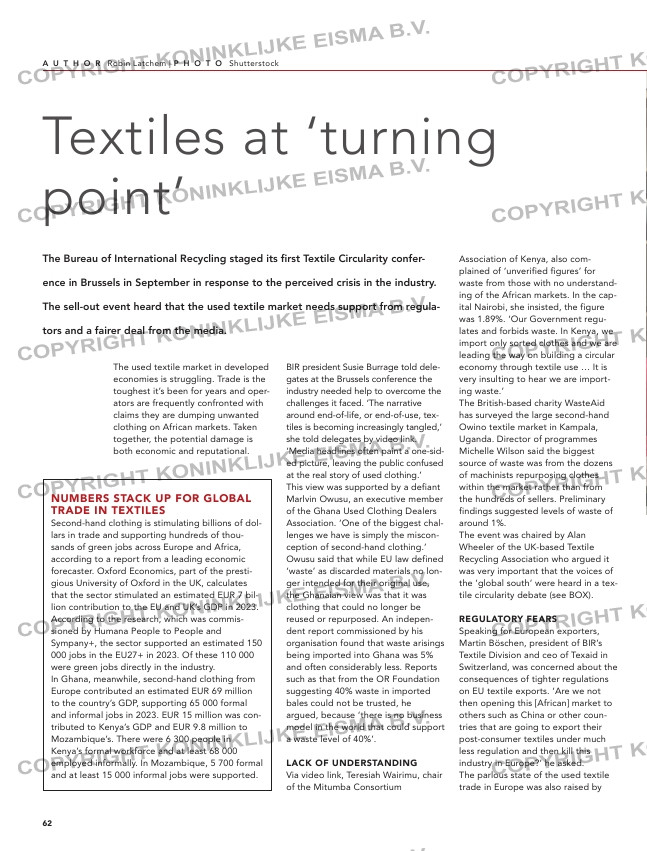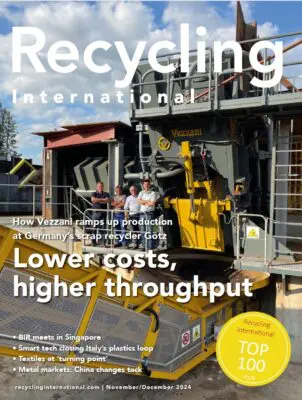Page 62 from: Recycling International November/December issue 2024

62
Textiles at ‘turning
point’
The Bureau of International Recycling staged its first Textile Circularity confer-
ence in Brussels in September in response to the perceived crisis in the industry.
The sell-out event heard that the used textile market needs support from regula-
tors and a fairer deal from the media.
Mariska Boer, president of EuRIC
Textiles and co-owner of Boer Group
in the Netherlands. ‘Our biggest chal-
lenge is finding a way to regain a
competitive position on the global
market for textile reuse. It’s only
through that we can continue to build
a resilient and vibrant industry here in
Europe.’
‘FAST FASHION’ BLUES
Boer spoke of a continuing decline
over the past 10-15 years in the quali-
ty of clothing put on the market by
brands selling ‘cheap, ultra-fast fash-
ion’. ‘If you get a lower quality in your
sorting plant you can’t possibly sort a
higher quality out.’
Other factors weighing on the reuse
The used textile market in developed
economies is struggling. Trade is the
toughest it’s been for years and oper-
ators are frequently confronted with
claims they are dumping unwanted
clothing on African markets. Taken
together, the potential damage is
both economic and reputational.
BIR president Susie Burrage told dele-
gates at the Brussels conference the
industry needed help to overcome the
challenges it faced. ‘The narrative
around end-of-life, or end-of-use, tex-
tiles is becoming increasingly tangled,’
she told delegates by video link.
‘Media headlines often paint a one-sid-
ed picture, leaving the public confused
at the real story of used clothing.’
This view was supported by a defiant
Marlvin Owusu, an executive member
of the Ghana Used Clothing Dealers
Association. ‘One of the biggest chal-
lenges we have is simply the miscon-
ception of second-hand clothing.’
Owusu said that while EU law defined
‘waste’ as discarded materials no lon-
ger intended for their original use,
the Ghanaian view was that it was
clothing that could no longer be
reused or repurposed. An indepen-
dent report commissioned by his
organisation found that waste arisings
being imported into Ghana was 5%
and often considerably less. Reports
such as that from the OR Foundation
suggesting 40% waste in imported
bales could not be trusted, he
argued, because ‘there is no business
model in the world that could support
a waste level of 40%’.
LACK OF UNDERSTANDING
Via video link, Teresiah Wairimu, chair
of the Mitumba Consortium
Association of Kenya, also com-
plained of ‘unverified figures’ for
waste from those with no understand-
ing of the African markets. In the cap-
ital Nairobi, she insisted, the figure
was 1.89%. ‘Our Government regu-
lates and forbids waste. In Kenya, we
import only sorted clothes and we are
leading the way on building a circular
economy through textile use … It is
very insulting to hear we are import-
ing waste.’
The British-based charity WasteAid
has surveyed the large second-hand
Owino textile market in Kampala,
Uganda. Director of programmes
Michelle Wilson said the biggest
source of waste was from the dozens
of machinists repurposing clothes
within the market rather than from
the hundreds of sellers. Preliminary
findings suggested levels of waste of
around 1%.
The event was chaired by Alan
Wheeler of the UK-based Textile
Recycling Association who argued it
was very important that the voices of
the ‘global south’ were heard in a tex-
tile circularity debate (see BOX).
REGULATORY FEARS
Speaking for European exporters,
Martin Böschen, president of BIR’s
Textile Division and ceo of Texaid in
Switzerland, was concerned about the
consequences of tighter regulations
on EU textile exports. ‘Are we not
then opening this [African] market to
others such as China or other coun-
tries that are going to export their
post-consumer textiles under much
less regulation and then kill this
industry in Europe?’ he asked.
The parlous state of the used textile
trade in Europe was also raised by
Textile recyclers are experiencing a decline in the quality of clothing put on the market by brands selling cheap, ultra-fast fashion. If you get a lower
quality in your sorting plant you can’t possibly sort a higher quality out, they argue.
A U T H O R Robin Latchem | P H O T O Shutterstock
NUMBERS STACK UP FOR GLOBAL
TRADE IN TEXTILES
Second-hand clothing is stimulating billions of dol-
lars in trade and supporting hundreds of thou-
sands of green jobs across Europe and Africa,
according to a report from a leading economic
forecaster. Oxford Economics, part of the presti-
gious University of Oxford in the UK, calculates
that the sector stimulated an estimated EUR 7 bil-
lion contribution to the EU and UK’s GDP in 2023.
According to the research, which was commis-
sioned by Humana People to People and
Sympany+, the sector supported an estimated 150
000 jobs in the EU27+ in 2023. Of these 110 000
were green jobs directly in the industry.
In Ghana, meanwhile, second-hand clothing from
Europe contributed an estimated EUR 69 million
to the country’s GDP, supporting 65 000 formal
and informal jobs in 2023. EUR 15 million was con-
tributed to Kenya’s GDP and EUR 9.8 million to
Mozambique’s. There were 6 300 people in
Kenya’s formal workforce and at least 68 000
employed informally. In Mozambique, 5 700 formal
and at least 15 000 informal jobs were supported.
62-63_birtextiles.indd 62 19-11-2024 14:16



